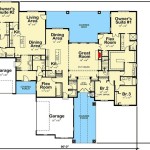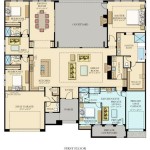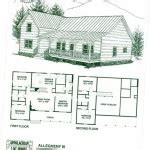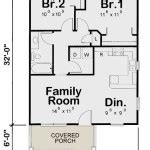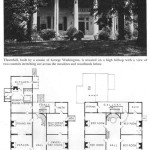Making your own house plans refers to the process of designing and drafting the blueprints for your future home without relying on professional architects. This involves conceptualizing the layout, room dimensions, and overall aesthetics of the house, as well as considering practical factors such as site conditions, building codes, and energy efficiency. For instance, if you have a specific vision for your dream home but find it challenging to articulate it to an architect, creating your own house plans can empower you to realize those ideas.
Embarking on this endeavor requires a combination of creativity, technical knowledge, and meticulous planning. While it can be an ambitious undertaking, it also offers numerous benefits. By making your own house plans, you gain complete control over the design process, ensuring that your home perfectly aligns with your preferences and lifestyle. It can also lead to substantial cost savings compared to hiring an architect, as well as provide a deep sense of accomplishment and satisfaction when you see your vision come to life.
In this article, we will guide you through the essential steps involved in making your own house plans, from gathering inspiration and determining your needs to creating detailed drawings and navigating the building permit process. We will cover various software and resources available to assist you, and provide tips for effective collaboration with contractors and other professionals involved in the construction process.
Making your own house plans requires careful consideration and attention to detail. Here are 10 important points to keep in mind:
- Define your needs: Determine the size, layout, and features that are essential for your lifestyle.
- Research building codes: Ensure your plans comply with local regulations and safety standards.
- Choose the right software: Utilize user-friendly software to create detailed and accurate drawings.
- Consider energy efficiency: Design your home to minimize energy consumption and reduce utility costs.
- Plan for future expansion: Anticipate potential changes in your needs and incorporate flexibility into your plans.
- Collaborate with contractors: Seek input from professionals to ensure your plans are buildable and cost-effective.
- Obtain building permits: Secure necessary approvals from local authorities before starting construction.
- Review and refine: Continuously assess and improve your plans throughout the design process.
- Document your decisions: Keep a record of your design choices and rationale for future reference.
- Enjoy the process: Making your own house plans should be an empowering and rewarding experience.
By following these points, you can create house plans that meet your specific requirements, reflect your personal style, and provide a solid foundation for your dream home.
Define your needs: Determine the size, layout, and features that are essential for your lifestyle.
When embarking on the journey of making your own house plans, it is crucial to begin by clearly defining your needs and aspirations for your future home. This involves carefully considering the size, layout, and features that are essential for your lifestyle, both now and in the future. To ensure that your house plans perfectly align with your vision and provide a comfortable and functional living space, take the time to thoroughly assess your current and anticipated needs.
Start by determining the optimal size for your home. Consider the number of bedrooms and bathrooms you require, as well as the amount of living space you need to accommodate your daily activities and entertain guests comfortably. Think about the size of your family, your hobbies, and any special requirements you may have, such as a home office or a dedicated workshop. Remember to consider not only your current needs but also your potential future needs, such as expanding your family or pursuing new hobbies.
Next, focus on the layout of your home. Sketch out different floor plans and experiment with various arrangements of rooms to find the configuration that best suits your lifestyle. Consider the flow of traffic between rooms, the placement of windows for natural light and ventilation, and the overall functionality of the space. Think about how you want to use each room and how the different areas of the house will connect and interact with each other.
Finally, identify the features that are essential for your comfort and convenience. Make a list of the amenities you desire, such as a gourmet kitchen, a luxurious bathroom, or a spacious outdoor living area. Consider your personal preferences and daily routines, and prioritize the features that will make your home a truly enjoyable and livable space. Don’t forget to think about storage solutions, energy efficiency, and smart home technology features that can enhance your daily life and provide peace of mind.
By taking the time to carefully define your needs and aspirations, you will lay a solid foundation for your house plans and ensure that your future home is tailored to your unique lifestyle and preferences.
Research building codes: Ensure your plans comply with local regulations and safety standards.
Before finalizing your house plans, it is essential to thoroughly research and understand the building codes and regulations applicable to your area. Building codes are established by local authorities to ensure the safety and structural integrity of buildings, as well as to promote energy efficiency and environmental sustainability. By adhering to these codes, you can avoid costly delays or even legal issues during the construction process.
- Obtain building code documents: Start by acquiring copies of the building codes and zoning regulations from your local building department or online. These documents outline the specific requirements and restrictions that apply to residential construction in your area.
- Review zoning regulations: Zoning regulations determine the permitted uses of land and the types of structures that can be built in different zones. Ensure that your house plans comply with the zoning regulations for your property, including setback requirements, height restrictions, and allowable building footprints.
- Check building codes: Building codes address various aspects of construction, including structural design, fire safety, plumbing, electrical systems, and energy efficiency. Carefully review the relevant sections of the building codes to ensure that your plans meet the minimum standards for safety and habitability.
- Consider energy efficiency codes: Many localities have adopted energy efficiency codes to promote sustainable building practices and reduce energy consumption. These codes may include requirements for insulation, window glazing, and energy-efficient appliances. By incorporating energy efficiency measures into your house plans, you can save money on utility bills and contribute to a greener environment.
By thoroughly researching building codes and ensuring that your house plans comply with all applicable regulations, you can avoid potential problems down the road and build a safe, legal, and energy-efficient home.
Choose the right software: Utilize user-friendly software to create detailed and accurate drawings.
Choosing the right software is crucial for creating detailed and accurate house plans. User-friendly software can simplify the design process, allowing you to focus on your creativity and vision without getting bogged down by technical complexities. Look for software that offers a range of features, including:
- Intuitive user interface: The software should be easy to navigate and use, with a logical layout and clear menus. This will allow you to quickly learn the program and start creating your plans.
- Comprehensive design tools: Choose software that provides a wide range of design tools, including tools for drawing walls, windows, doors, and other architectural elements. Look for software that allows you to easily create custom shapes and modify objects.
- 3D modeling capabilities: 3D modeling allows you to visualize your home in three dimensions, which can be helpful for making design decisions and identifying potential problems. Choose software that offers robust 3D modeling features and allows you to easily switch between 2D and 3D views.
- Export and sharing options: The software should allow you to easily export your plans in a variety of formats, such as PDF, DWG, and DXF. This will enable you to share your plans with contractors, engineers, and other professionals involved in the construction process.
By choosing the right software, you can create detailed and accurate house plans that will serve as a solid foundation for your dream home. Take the time to research different software options and choose the one that best meets your needs and skill level.
Consider energy efficiency: Design your home to minimize energy consumption and reduce utility costs.
In today’s environmentally conscious world, it is more important than ever to design homes that are energy efficient. By incorporating energy-saving features into your house plans, you can significantly reduce your energy consumption and utility bills, while also contributing to a greener planet.
There are many ways to improve the energy efficiency of your home, including:
- Insulate your home well: Insulation is one of the most effective ways to reduce heat loss in the winter and heat gain in the summer. Make sure your walls, roof, and floors are properly insulated to minimize energy waste.
- Install energy-efficient windows and doors: Windows and doors are another major source of heat loss. Choose energy-efficient windows and doors that are designed to minimize air leakage and heat transfer.
- Use energy-efficient appliances: When purchasing appliances, look for models that are Energy Star certified. Energy Star appliances meet strict energy efficiency standards, which can help you save money on your energy bills.
- Install a programmable thermostat: A programmable thermostat allows you to set different temperatures for different times of the day. This can help you save energy by reducing the temperature when you are away from home or asleep.
By following these tips, you can design a home that is both energy efficient and comfortable. You will save money on your utility bills, reduce your carbon footprint, and create a healthier and more sustainable living environment.
In addition to the measures mentioned above, there are a number of other ways to improve the energy efficiency of your home. These include:
- Use natural light: Natural light can help reduce the need for artificial lighting, which can save energy.
- Plant trees around your home: Trees can help shade your home in the summer and reduce heat gain. They can also help block wind in the winter, which can reduce heat loss.
- Use renewable energy sources: Consider using renewable energy sources, such as solar panels or a geothermal heat pump, to power your home. Renewable energy sources can help you reduce your reliance on fossil fuels and save money on your energy bills.
Plan for future expansion: Anticipate potential changes in your needs and incorporate flexibility into your plans.
When making your own house plans, it is important to consider your future needs and incorporate flexibility into your design. Your needs may change over time, so it is important to plan for potential changes and make sure your home can adapt to them. Here are a few things to consider:
- Changing family size: If you are planning to have children in the future, you may want to design your home with extra bedrooms and bathrooms. You may also want to consider adding a playroom or a dedicated study space for your children.
- Aging in place: If you are planning to stay in your home as you get older, you may want to incorporate features that will make it easier to age in place. This could include things like wider doorways, grab bars in the bathroom, and a first-floor bedroom.
- Changing lifestyle: Your lifestyle may change over time, so it is important to design your home with flexibility in mind. For example, if you are planning to start a home-based business, you may want to design your home with a dedicated office space. Or, if you are planning to retire, you may want to design your home with a smaller footprint and less maintenance.
- Resale value: If you are planning to sell your home in the future, it is important to design your home with resale value in mind. This means designing a home that is appealing to a wide range of buyers. For example, you may want to avoid designing a home with a very specific or unique style.
By considering your future needs and incorporating flexibility into your house plans, you can create a home that will meet your needs for many years to come.
Collaborate with contractors: Seek input from professionals to ensure your plans are buildable and cost-effective.
Once you have created a preliminary design for your home, it is important to collaborate with contractors to get their input and feedback. Contractors can provide valuable insights into the buildability and cost-effectiveness of your plans. They can also help you identify any potential problems or challenges that you may not have considered.
There are several ways to collaborate with contractors. One option is to hire a contractor to review your plans and provide a cost estimate. This can be a good way to get an idea of the total cost of your project and to identify any areas where you can save money. Another option is to work with a contractor on a design-build basis. This means that the contractor will be involved in the design process from the beginning, which can help to ensure that your plans are buildable and cost-effective.
No matter how you choose to collaborate with contractors, it is important to be open to their feedback and suggestions. Contractors have a wealth of knowledge and experience, and they can help you to create a home that is both beautiful and functional.
Here are some specific benefits of collaborating with contractors:
- Contractors can help you to identify potential problems or challenges with your plans. This can save you time and money in the long run by avoiding costly mistakes during construction.
- Contractors can provide valuable insights into the latest building materials and techniques. This can help you to make informed decisions about the design and construction of your home.
- Contractors can help you to stay within your budget. They can provide you with cost estimates and help you to identify ways to save money on your project.
By collaborating with contractors, you can ensure that your house plans are buildable, cost-effective, and meet your specific needs and preferences.
Obtain building permits: Secure necessary approvals from local authorities before starting construction.
Once you have finalized your house plans, the next step is to obtain building permits from your local authorities. Building permits are required to ensure that your plans comply with all applicable building codes and zoning regulations. The permitting process typically involves submitting your plans to the local building department for review and approval. The building department will review your plans to ensure that they meet all of the minimum safety and construction standards.
The building permit process can vary from one jurisdiction to another, but there are some general steps that are typically involved. First, you will need to submit your plans to the local building department. The plans should include a site plan, floor plans, elevations, and any other drawings that are required by the building department. The building department will then review your plans to ensure that they comply with all of the applicable building codes and zoning regulations.
Once the building department has approved your plans, you will need to pay a permit fee. The permit fee is typically based on the square footage of your home. Once you have paid the permit fee, you will be issued a building permit. The building permit will allow you to start construction on your home.
It is important to note that building permits are typically only valid for a limited period of time. If you do not start construction on your home within the time period specified on the permit, you will need to renew the permit.
Obtaining building permits is an important step in the construction process. By following the steps outlined above, you can ensure that your plans are approved by the local authorities and that your home is built to code.
Review and refine: Continuously assess and improve your plans throughout the design process.
Once you have created a preliminary design for your home, it is important to continuously review and refine your plans. This involves carefully assessing your plans, identifying areas for improvement, and making changes as needed. By continuously refining your plans, you can ensure that your final design is well-thought-out, functional, and meets your specific needs and preferences.
There are several ways to review and refine your plans. One way is to simply take a step back from your plans and look at them with a fresh perspective. This can help you to identify any areas that need improvement. Another way to review your plans is to get feedback from others. This could include friends, family members, or even a professional architect or designer. Getting feedback from others can help you to identify areas that you may have overlooked or that could be improved.
Once you have identified areas for improvement, you can start to make changes to your plans. Be sure to consider the impact of any changes you make on the overall design of your home. It is also important to make sure that any changes you make comply with all applicable building codes and zoning regulations.
The review and refine process is an ongoing one. As you continue to work on your plans, you will likely identify additional areas for improvement. By continuously reviewing and refining your plans, you can ensure that your final design is the best it can be.
Here are some specific tips for reviewing and refining your house plans:
- Take your time: Don’t rush the design process. Take your time to carefully consider your needs and preferences, and to explore different design options. The more time you spend on the design process, the better your final plans will be.
- Get feedback from others: Ask friends, family members, or even a professional architect or designer to review your plans and provide feedback. Getting feedback from others can help you to identify areas that you may have overlooked or that could be improved.
- Make changes as needed: Once you have identified areas for improvement, don’t be afraid to make changes to your plans. The goal is to create a design that is perfect for you and your needs.
- Don’t be afraid to start over: If you’re not happy with your plans, don’t be afraid to start over. It’s better to start over with a clean slate than to try to salvage a design that you’re not happy with.
Document your decisions: Keep a record of your design choices and rationale for future reference.
As you make decisions about your house plans, it is important to document your choices and the reasons behind them. This will help you to keep track of your design decisions and to remember the rationale behind them. It will also be helpful if you need to make changes to your plans in the future or if you need to explain your design choices to others.
There are several ways to document your design decisions. One way is to simply keep a notebook or journal where you can record your thoughts, ideas, and decisions. Another way to document your decisions is to use a digital tool, such as a spreadsheet or a word processing document. You can also use a combination of methods to document your decisions.
No matter which method you choose, it is important to be consistent and to document your decisions in a way that is easy to understand and follow. Be sure to include the following information in your documentation:
- The date of the decision: This will help you to track the progress of your design process.
- The decision that you made: Be specific about the decision that you made and include any relevant details.
- The rationale behind the decision: Explain why you made the decision that you did. This will help you to remember your thought process and to make informed decisions in the future.
Documenting your design decisions is an important part of the design process. By keeping a record of your choices and the reasons behind them, you can ensure that your final design is well-thought-out and meets your specific needs and preferences.
Enjoy the process: Making your own house plans should be an empowering and rewarding experience.
Making your own house plans is not just about creating a set of blueprints. It is about envisioning your dream home and translating that vision into a reality. It is an opportunity to be creative, to learn new skills, and to take control of one of the most important investments you will ever make. The process of making your own house plans can be challenging, but it should also be enjoyable and rewarding.
Here are a few tips for making the most of the experience:
- Set realistic expectations: Don’t expect to sit down and create perfect house plans overnight. It takes time and effort to develop a well-thought-out design. Be patient with yourself and don’t be afraid to make mistakes. The more you work on your plans, the better they will become.
- Do your research: Before you start drawing up plans, take some time to research different house plans and designs. This will help you to get ideas and to learn about the different options that are available. You can find house plans online, in books, and in magazines. You can also visit model homes and talk to builders and architects.
- Use software to your advantage: There are a number of software programs available that can help you to create house plans. These programs can make the design process easier and more efficient. However, it is important to choose a software program that is right for your skill level and needs.
- Get feedback from others: Once you have created a preliminary design, get feedback from friends, family, or a professional. This feedback can help you to identify areas for improvement and to make sure that your plans are realistic.
Making your own house plans can be a lot of work, but it is also a lot of fun. By following these tips, you can make the most of the experience and create a home that you will love for years to come.










Related Posts



